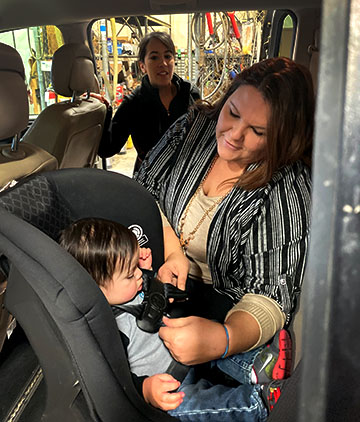
PBPN member Nib-Akwa Otero watches Rachael McCoy, Transportation Lead Driver adjust the harness straps of his car seat, as mom Megan Otero looks on from the door.
The PBPN General Public Transportation (PBPN GPT) department is a coalition member of Safe Kids – Prairie Band Potawatomi Nation and is now available to assist the community with car seats.
Rachael McCoy, PBPN GPT Lead Driver/Transportation Driver Supervisor recently attended training receiving certification as a Child Passenger Safety Technician. McCoy can assist the community in installing seats, providing seats, and answering car seat related questions from product recalls to car seat laws.
“As a mother, I know the importance of keeping our babies safe,” said McCoy.
McCoy can be reached at 785-966-2995 locally or toll-free 1-866-727-8181 for questions or to set up an appointment. The PBPN General Public Transportation department is located at 15185 K Road, Mayetta, Kan. Service is available Monday to Friday, 8 a.m. to 4:30 p.m., and operates on a first-come, first-served basis. This project is funded by the KDOT Public Transportation Program.
Individuals can also access the Safe Kids website www.safekids.org for up-to-date information by state. Here are a few Child Passenger Safety Laws for the state of Kansas, courtesy of safekids.org:
- A child restraint is required for children 3 years and younger
- The maximum fine for a first car seat violation is $60
- Children can start using a seat belt at age 8 or from age 4 to 7 if the child is over 80 pounds or taller than 57 inches
- The law provides immunity to a person rescuing a child from a hot car
Top 5 Recommendations for Protecting Your Child, courtesy of the Governors Highway Association & the Insurance Institute for Highway Safety:
- For the best protection, keep kids in a rear-facing car seat until they are at least age two and have outgrown the height or weight limit on the label of the car seat. Keep them in the safer rear-facing position as long as possible, because kids who ride rear-facing have the best protection for their head, neck and spine.
- Children who have outgrown their rear-facing car seat move to a forward-facing seat with a harness. Keep them in the forward-facing car seat until they reach the weight or height limits on the label of the car seat. Remember to use the car seat’s tether to secure the forward-facing car seat to the car.
- After a child gets too big for the weight or height limits listed on the forward-facing car seat’s label, move to a booster seat used with the vehicle lap and shoulder seat belt.
- A child is ready for using the seat belt alone when they pass these three tests: The child’s knees should bend at the edge of the seat when their backs and bottoms are against the vehicle seat back; the vehicle lap belt fits snugly across the bony hips or upper thighs (not soft stomach), and the shoulder belt fits across the bony shoulder and chest (not across the soft face or neck.)
- All children under 13 years of age are safest riding in a back seat.
